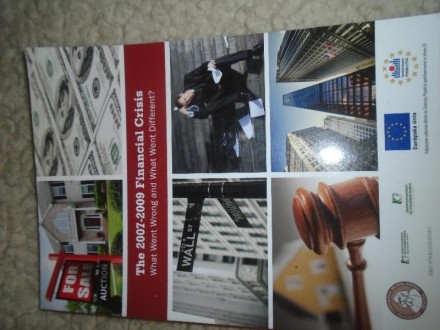The 2007-2009 Financial Crisis
| Cena: |
| Stanje: | Polovan bez oštećenja |
| Garancija: | Ne |
| Isporuka: | Post Express Lično preuzimanje |
| Plaćanje: | Tekući račun (pre slanja)
Lično |
| Grad: |
Novi Sad, Novi Sad |
ISBN: Ostalo
Godina izdanja: 2011
Oblast: Ekonomija
Jezik: Engleski
Autor: Strani
The 2007-2009 Financial Crisis
What Went Wrong and What Went Different?
Z. GÁL: THE 2007-2009 FINANCIAL CRISIS
It started with rising delinquencies and foreclosures on the American property market in 2007, when the majority (including top US government and central bank officials) still believed that it was a crisis of mortgage finance (or a special segment of it) and that the problems would not spread to the rest of the economy. For most, a severe crisis was unimaginable in developed countries with sophisticated financial sectors, especially in the leading economy in the world. However, by the autumn of 2008 the crisis had brought Wall Street to the verge of collapse. Unprecedented scenes followed: bankruptcies or bailouts of the masters of the financial universe, including the two largest financial corporations of America (Fannie Mae and Freddie Mac), the largest insurance company in the world (AIG) and all of the five big Wall Street investment banks. It soon went global, after the collapse of Lehman Brothers interbank lending was frozen worldwide, central banks (the lenders of last resort) remained the lenders of only resort. The United Kingdom witnessed the first run on a bank in more than a century, mortgage lenders, banks, corporations and even countries all around the world went bankrupt or were bailed out almost on a daily basis. By 2009, it was clear that this was the largest global financial crisis since the Great Depression. How could American borrowers defaulting on their mortgages (in volumes of tens or hundreds of billions of dollars) trigger a multitrillion dollar global financial meltdown? How was it possible in the United States to get a mortgage loan up to 100% of the value of the property without verified income, job or assets? How could financial innovations praised for a long time lead to a chain reaction wiping out whole segments of the financial industry? How could so many financial institutions be so fragile that a few percentage points loss in their asset portfolio would bring them to the brink of bankruptcy? How did government action and inaction not only allow this to happen but contribute to it, turning America to a big financial Las Vegas? A giant casino, where (unlike in real gambling casinos) the bets are guaranteed by the government, so almost everybody is gambling because one can never lose, the gains are privatized, and the losses nationalized. How it was possible to gamble for so long without serious consequences? In his search for answers to these questions, Zsolt Gál in his book examines the causes of the last financial crisis He offers a detailed view on the incentives of various actors, showing that gambling from Main Street to Wall Street was rather a rational strategy as the consequence of pervasive systemic motivations. One should change the system challenging these motivations to prevent history from repeating itself.
http://www.limundo.com/aukcije-Nana30
http://www.kupindo.com/Clan/Nana30/SpisakPredmeta
Odeća je uglavnom iz Nemačke,znači sve je kvalitetno.
Ono što ima neki nedostatak,to je naznačeno na datoj aukciji.
Veliki izbor stvari za decu i odrasle za predstojeći period.
Poštarina ide na teret kupca,šaljem isključivo Post Expressom.Poštarina je stavljena okvirno.Može i lično preuzimanje, što podrazumeva preuzimanje na mojoj adresi.
Pogledajte i ostale moje aukcije,kupite više stvari,
platite jednu poštarinu.
Od pobednika očekujem da poštuje pravila Kupinda i da se javi u predviđenom roku, kao i da izvrši uplatu u istom na moj tekući račun.U protivnom sledi negativna ocena i prijava administratorima.Šaljem posle uplate na moj račun.
Molim neozbiljne kupce da ne licitiraju,licitirajte samo u slučaju da ste sigurni da hoćete da kupite izlicitiran predmet.
Slike su u visokoj rezoluciji i detaljno se vidi u kakvom je stanju predmet.
Ne odgovaram za štetu koja je nastala u toku transporta.
Dobro pročitajte uslove pre nego licitirate.
Ne šaljem pouzećem,preporučeno i ne šaljem u inostranstvo !!!!
Srećno !!!
Pogledajte sve moje ponude na Limundu i na Kupindu:
http://www.limundo.com/aukcije-Nana30
http://www.kupindo.com/Clan/Nana30/SpisakPredmeta
Predmet: 60824009











